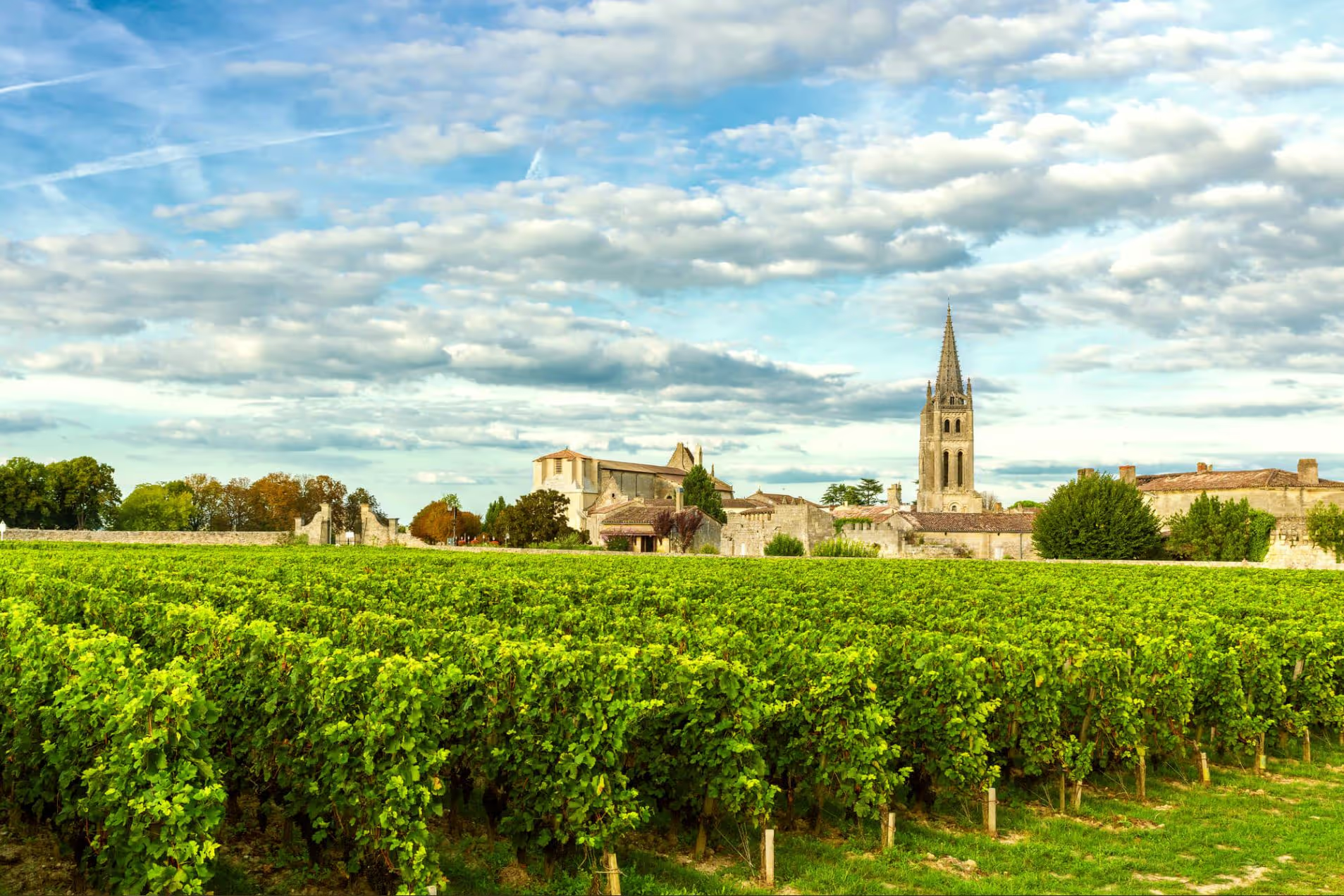The Bordeaux wine region: fine wine with history

The Bordeaux wine region is synonymous with excellent French red wine and — together with Burgundy — is considered one of the best growing regions worldwide. Discover with us the special territorial features of the region, its historical development, famous châteaus and top wines.
The wine region between river and sea
The Bordeaux region is located in western France. Its northern part is crossed by the Dordogne and Garonne rivers, which unite at the city of Bordeaux in the Gironde. This results in two areas: “Rive droite” with the Saint Émilion, Fronsac and Pomerol appellations and “Rive gauche” with Médoc, Sauternes and Graves.
The world's largest, closed growing area is located on a limestone base. The gravel and mud of the Garonne has enriched the soil and subsoil of the region with various types of clay and stone over the centuries. Limestone, river stones and siliceous soil form the basis for multi-faceted wines. The wine-growing region is also influenced by the proximity of the Atlantic, which moderates the climate and shapes the unique character of the excellent wines
Bordeaux comprises approximately 120,000 hectares of vineyards, which is spread over 57 different appellations and covers two thirds of the Gironde department. Around 3000 wineries there are Almost six million hectoliters of wine produces. Mainly red grape varieties, but the region is also known for excellent white wines.
Historical development
Bordeaux has over 2000 years of history, whose beginnings are marked by Celts, Franks and Romans, who introduced viticulture. Due to its favourable location, the city of Bordeaux gained reputation in ancient times and developed into a trading hub. The following centuries allowed the city and region to flourish economically, as Bordeaux wines were exported in large quantities to Great Britain and later all over the world.
Because of the size and complexity of the growing area, it was and is a science in itself to assess the quality of châteaus in Bordeaux. That is why the first classification was made under Napoleon III. At the 1855 World's Fair in Paris, the most important association of wine retailers in Bordeaux decided to award the five-stage classification very pragmatically: The wines were not tasted “against each other.” Instead, the reputation of the individual wineries and the market prices achieved for their wines were assessed. The only revision of the classification, which is still valid today, was in 1973 when Château Mouton Rothschild was promoted from the 2nd Grand Cru Classé to the rank of 1er Grand Cru Classé.
To the Classification wineries From 1855, for example, include:
Premier Grand Cru Class:
- Chateau Lafite-Rothschild (Pauillac)
- Chateau Latour (Pauillac)
- Chateau Margaux (Margaux)
- Château Mouton-Rothschild (Pauillac), since 1973, previously Deuxième Cru
- Chateau Haut-Brion (Pessac in Graves)
Second Grand Cru Class:
- Chateau Rausan-Segla (Margaux)
- Chateau Leoville-las-Cases (Saint-Julien)
- Chateau Pichon-Longueville-Comtesse de Lalande (Pauillac)
Three Grand Cru Classe:
- Château Lagrange (Saint-Julien)
- Chateau Giscours (Labarde-Margaux)
- Chateau Cantenac-Brown (Cantenac-Margaux)
Quatrième Grand Cru Classé:
- Château Branaire-Ducru (Saint-Julien)
- Chateau Duhart-Milon-Rothschild (Pauillac)
- Château Beychevelle (Saint-Julien)
Fifth Grand Cru Class:
- Chateau Pontet-Canet (Pauillac)
- Chateau Grand-Puy-Lacoste (Pauillac)
- Chateau Lynch-Bages (Pauillac)
However, the red wine classification of 1855 does not cover all appellations in Bordeaux, which is why further classification systems were developed in neighboring regions in subsequent years and decades.
Famous grape varieties and châteaus
Classic Bordeaux wine is a cuvée — i.e. a wine blended from several grape varieties. 85 to 90 percent of Bordeaux's vineyards are home to red grape varieties. These are dominated by Cabernet Franc, Cabernet Sauvignon and Merlot, with a share of around 90 percent. Each winery has its own blend of grape varieties and vinification, which creates a very special characteristic of the wines. In the case of white wines, Sémillon with over 50 percent the most important type.
Basically, every winery in Bordeaux is referred to as a château (castle), although not every building meets this architectural standard. Médoc and its Pauillac sub-region are home to some of the world's most famous wineries: Chateau Lafite-Rothschild, Château Latour and Château Mouton-Rothschild. According to the Bordeaux classification of 1855, all three belong to the Premier Cru Classé. The Médoc wine-growing region thus owns three of the five châteaus classified as Premier CRU.
Award-winning top wines from Bordeaux
that Chateau Le Pin is a small castle in the Pomerol appellation, on the right bank of the Bordeaux region. Its low production volume of only 600-700 cases per year on average and the very high quality result in collector prices, which make Le Pin one of the most expensive wines from Bordeaux. Another small but fine appellation in Pomerol is the famous Château Petrus, whose legendary wine is made from almost 100% Merlot.
Connoisseurs and enthusiasts usually associate the term Bordeaux with particularly expressive, rich, substantive and, above all, expensive wines. The “big” Bordeaux red wines mature for at least 20 years to fully develop. However, wine critic Robert Parker assumes “that most is drunk before it reaches its height.” This is good for fine wine investors, because every bottle of exceptional wine that is opened shortens the supply. Also because wine consumption has become a status symbol of a growing middle class in more and more emerging countries.
Investors, on the other hand, value Bordeaux wines with a maximum premium of 99 or 100 Parker points primarily as an alternative, market-stable addition to their portfolio. However, buyers without in-depth expert knowledge also take risks: If a wine is poorly stored for years, it loses dramatically in quality and value. Fine wine investors should therefore ensure that the bottles are sourced and stored professionally as possible — or the know-how for the investment process experienced specialist fall back on.



